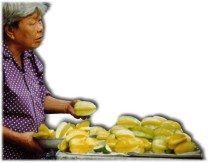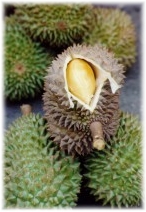
Chinese influence in Northeast Asia and Vietnam has been significant. In
Southeast Asia, India's influence has far outpaced that other behemoth
in historical terms. More recently, Chinese migrants to Southeast Asia
have wielded tremendous influence even if that influence has been mostly confined
to the economic sphere. Whereas India's influence can be seen in the cultures
of nations like Burma, Thailand, Indonesia and Malaysia, Chinese influence
has not significantly permeated this area of Nanyang (lands that are reached from the ocean which extends from South China). Western scholars of racism and ethnic prejudice argue
that the extent to which a migrant group becomes assimilated by the host
group is directly proportional to the host group's willingness to permit
assimilation. The supposition is that assimilation is necessary, in historical
terms at least, for people to peacefully coexist within one nation's boundaries.
Maybe a century from now we can fairly evaluate this supposition.
Just as there have been those that lay the blame of ethnic conflict
on the host nations, there are those that have worshipped the economic
success of the huaqiao, or overseas Chinese, throughout Southeast.
It's as if these Chinese migrants are both wandering victims and brilliant
economists. No one ever seems to make the connection. Emigrant communities
are known to be better than the bottom of the barrel of any society for
they would never have the wherewithal to escape the oppression of their
home. As emigrants, their focus and determination to survive, if not prosper
economically should be naturally understood as well. A third feature of
economic success of ghettoized sub-societies is just this. Social rules
which constrain anti-social behavior in one group creates an opportunity
for the outside group which necessarily has an alternative set of rules
that are necessary for survival. In other words, I am free to exploit the
economic opportunities that the host society has sanctions against principally
because I am not one of them. Who can say what came first in driving the
wedge between ethnic Chinese immigrants and their host societies throughout
Southeast Asia: religion, diet, fashions, customs, or business practices.
Today the Chinese like a shop owner I spoke with in Melaka, who told me
that the Malays have more children than they could afford, blame the Malays
for frivolous habits or laziness. Comparatively disadvantaged Malays, on
the other hand, often criticize ethnic Chinese claiming they have unscrupulous
business practices. This wedge that exists between these two ethnic groups
sometimes proves fatal to Chinese communities in periodic bloodletting.
We forget that the average huaqiao is not rich, though they may
be slightly better off economically than the ethnic Malay. The bloodletting
only exacerbates problems causing the ethnic Chinese to loose any trust
they may have built up in the Malays. The political playing field is never
leveled - it always remains in the hands of the host ethnic groups even
when it includes truly assimilated Chinese as in Thailand and the Philippines.
Its with this framework such as I see it, right or wrong, that I look
at the ethnic Chinese of Malaysia and Singapore and share the subsequent
scattered experiences:
A Malay man wearing a kopiah approached us at the train station
near Kota Bharu to ask us if we would hire him to take us there. He wasn't
a professional taxi driver, merely an elderly man who owned a car, could
speak some English, and knew how to hustle a buck out of you. After negotiating
a price, we took his offer. In short time, we arrived in Kota Bharu and
declined to stay at the first hotel he showed us. Karen suggested to him
the name of a hotel that we had stayed at before, but he advised us against
it because "it's dirty." This made me suspicious because the hotel he showed
us, was if anything less clean than the one Karen had mentioned. When I
asked the receptionist at the hotel that he took us to instead, I was told
that it was owned by Malays. In all fairness, we didn't check the other
two hotels he drove us to see who owned them, and we have learned from
experience that Malay staff (when we did see the staff, they were Malay)
often work for Chinese owned businesses.
Imagine now the contrast between the relatively conservative dress of
the ethnic Malay women, only some of whom wear tudung, but most
of whom wear the long baju melayu, in contrast to young ethnic Chinese
women who can often be seen wearing very short skirts and tight-fitting
tops as they walk in public areas.
I met a friendly group of Malay teenaged boys in one of Singapore's
ubiquitous shopping areas and asked them about this contrast in fashions
between the two largest ethnic groups in the region. In advance, I realized
that any of their responses would be suspect because the comments of teens
toward a stranger in this setting might be subject to social braggadocio.
Pointing out examples of how some Chinese women in the area dressed, I
asked them what they thought. They said it was "good." Then I asked them
if it would be okay if their sisters dressed this way and the most outspoken
ventured a "Yes, but the short should not be too short." I suggested that
women in America, might get into trouble if they dressed the same way during
daytime (often accompanied only by girlfriends). I even went as far to
suggest that in America, people might suspect that they were prostitutes
(in retrospect, I think I was shocked by the contrast and used hyperbole).
They assured me that these women were certainly not and asked if rape was
a common problem in the U.S. When I asked if they felt they were more likely
to marry a woman who wore a tudung or a Chinese woman dressed in
such a way, the answer was quick and unequivocal: "one with a tudung."
So I asked, "Why?" "Because of religion," they told me.

Baba, or Straits Chinese, is a waning designation for those Chinese
and their descendants who immigrated to the Straits Settlements of Malaysia
(Penang, Melaka, and Singapore) or their environs and adopted some of the
Malay ways of speaking, dress, and customs. These Chinese are distinguished
from more recent immigrants, known before the Baba society began
to dissipate, as Totoks. Baba who held more steadfastly to Chinese
customs, dress, and most importantly, language. The Baba Chinese
never really assimilated so it is difficult to say if that which divides
the ethnic Chinese from the Malays has changed. The divide is palpable
and leads one to suspect how long it will be before another blood letting.
One day in Kuala Lumpur, I surmised a small group of men sitting at
the adjoining table drinking teh susu (tea with sweetened condensed
milk) were having a business meeting. Three of the young men were ethnic
Chinese and a fourth was ethnic Malay. The patois of this group of men
included some English words and specifically the word "taxes"
which accorded my suspicious mind the reason for the presence of the one
Bumiputera (a legalized term for ethnic Malays though technically
it refers to the natives of the soil). This Malay man, it seemed, was clearly
the odd man out. He didn't look particularly uncomfortable, but this in
itself revealed the spurious nature of this small informal meeting. The
three ethnic Chinese men never looked at each other in a way that revealed
a separate connection between any two of them or all three of them, but
they all looked equally uneasy when the Malay man would laugh good-humoredly
about something he himself would say. It was an obvious mismatch of personalities,
but something beyond that as well. Despite the presumed effort to build
a "relationship" such as the Chinese Indonesian man
I had spoken to, this Malay man was obviously out of sync with his
ethnic Chinese counterparts and yet his comrades made no hint at according
him any privileged status. Only putting up with him, in as much as their
personalities were mismatched, out of some unspoken necessity.
Can one's ability at commerce be derived from cultural upbringing? It
sounds preposterous, but do consider this not uncommon approach that I
was confronted with when I shopped in some Baba owned stores in Melaka:
"Do come in, it's much too hot out there." After purchasing a water at
the front of another shop, "Have a seat." The caretaker of the store points
the electric fan in my direction. After walking briefly into a third store,
I begin to exit and the proprietor hands me a cup of tea.

Chinese Starfruit Vendor, KL |

 I don't think I have ever seen the fondness expressed for a fruit that seemed
to have possessed people in Malaysia and Singapore while I traveled through
these two places. Large trucks brought this precious spiky-skinned fruit called
durian, to the edges of cities where small vans and cars took over. In
Melaka, I noticed the fruit was being sold from a car's trunk to several
customers. One man, who was missing much of his hand due to some unknown
incident, was hurriedly devouring the sticky fruit from this stump as if
in a trance that beckoned him with the promise to magically sprout a new
hand. In Singapore, several adult Chinese men stood at a corner eagerly
licking their fingers like young boys, savoring each taste of this amazing
fruit.
I don't think I have ever seen the fondness expressed for a fruit that seemed
to have possessed people in Malaysia and Singapore while I traveled through
these two places. Large trucks brought this precious spiky-skinned fruit called
durian, to the edges of cities where small vans and cars took over. In
Melaka, I noticed the fruit was being sold from a car's trunk to several
customers. One man, who was missing much of his hand due to some unknown
incident, was hurriedly devouring the sticky fruit from this stump as if
in a trance that beckoned him with the promise to magically sprout a new
hand. In Singapore, several adult Chinese men stood at a corner eagerly
licking their fingers like young boys, savoring each taste of this amazing
fruit.
|

